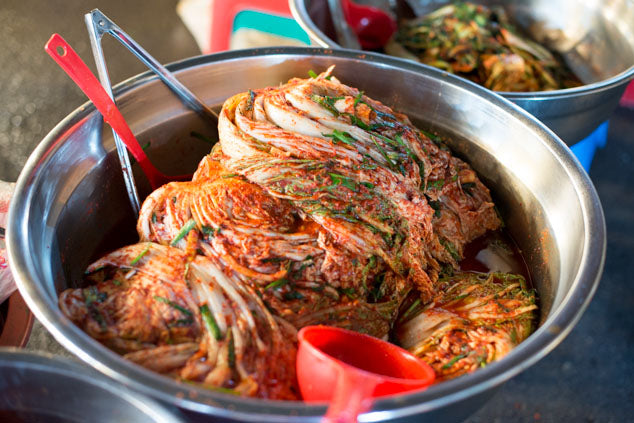Kimchi: Korea's Greatest Food?

For a complete how-to guide for homemade kimchi, read our How to Make Your Own Kimchi Recipe
It’s rare that a single food makes it into the history books. But when it comes to kimchi – the Korean specialty of hot, fizzy fermented cabbage – it can’t stay out of the spotlight.
Korean troops setting off to fight in Vietnam took homemade crocks of kimchi on the boats with them. Prime Minister Chung Il Kwon wasn’t quite so well-prepared on his visit to the White House, but confided in President Johnson that he ‘longed for kimchi more than his wife’. Even when the first Korean astronaut was preparing for space, the country invested millions of dollars and years of research to develop a kimchi for her to take on board. So as Yi So-Yeon orbited the earth, she still had a taste of home.
Kimchi's most recent historic moment was the Great Cabbage Crisis of 2010 which saw annual cabbage-price inflation soar by 400%. A single head of cabbage cost more than pork, and the Seoul City Government was forced to implement a 'kimchi bailout program', importing 300,000 subsidized cabbages to the kimchi-deprived city.
On overseas trips, Prime Minister Chung Il Kwon ‘longed for kimchi more than his wife’
Fermented vegetables have been a Korean food staple for millennia. When temperatures dropped to -20°C during the winter, Ancient Koreans relied on the earthenware onggi of fermenting vegetables buried in their garden to take them through to spring. Even today, Koreans average 200g of kimchi per day in the winter - double summertime consumption - showing how deeply ingrained the dish is in seasonal menus.
The recipes differ depending on the time of year – springtime varieties often use baby radishes and young cabbage. Cucumber kimchi (oi sobagi) is popular in summer months, while winter kimchi usually contains whole Napa cabbage and large daikon radishes. Much like chutney recipes though, different kimchis are often inspired by whatever food is closest to hand, rather than following specific, set recipes – Korean chef Hi Soo Shin Hepinstall remembers her family “using everything from cabbage to watermelon skin and even pumpkin blossom”.
different kimchis are often inspired by whatever food is closest to hand, rather than following specific, set recipes
For hundreds of years, kimchi was made at home – communities came together to make batches for the winter, and families tended to their own home-brew. But throughout the twentieth century, kimchi became big business. Large-scale immigration and the Seoul Olympics introduced the condiment to the rest of the world. Mass-production industrialised the craft, and fermented vegetables traveled the world in tins and jars and cans as Korea churned out 150,000 tons per year to keep up with demand.
Now kimchi-making joins the wider trend of a return to home production. As more people are baking their own sourdough, home-curing meat, and choosing homemade jams over the convenience of shop-bought varieties, so kimchi is often something cultivated with love - not bought from the shop. Not only is the taste far deeper and richer, but the fermentation process can be carefully monitored, allowing ‘home brewers’ to pick the exact time that the kimchi is at the perfect levels of fermentation for their own tastes.
David Chang has recipes for kimchi with oysters, kimchi and apple salad and kimchi purée with bacon and sprouts.
America in particular, is experiencing a kimchi-resurgence. David Chang, leader of the Korean food movement, has written recipes for kimchi with oysters, kimchi and apple salad and kimchi purée with bacon and sprouts. Kimchi burgers are creeping in to mainstream menus. Kimchi tacos are the product of an unexpected Mexican-Korean fusion, and we’ve even seen a little slosh of kimchi juice make its way into a Bloody Mary.
But for a traditional use of this romping, peppery, fizzy condiment, our current favourite use is kimchi bokkeumbap, pictured above. Let us know, how do you like to eat yours?


